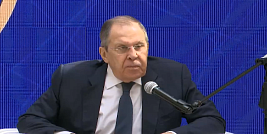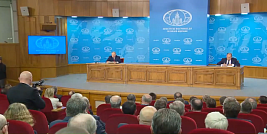Foreign Minister Sergey Lavrov’s video address on the 10th anniversary of the Crimean Spring, Moscow, March 16, 2024
Friends!
Ten years ago – on March 16, 2014 – the people of Crimea participated in a referendum, making an independent and informed choice to determine their own future by reuniting with Russia, thus exercising their right to self-determination in full compliance with the UN Charter and the Declaration on Principles of International Law.
The ensuing developments showed this was the only way to go, which made it possible to defend the lives, honour and dignity of the Crimean people from the encroachments of the Russophobic Kiev regime. We well remember that troubling and terrible spring, when the bloody coup brought neo-Nazis to power in Kiev. We also remember the notorious “friendship trains” that were packed off by the ideological followers of the Banderites to quell the protests of Crimean residents, who chose not to betray the values, culture, history and centuries-old traditions of their ancestors. The ensuing anti-Crimea sanctions, bombings of power lines, and the transport, energy and water blockades reinforced Crimean residents’ belief in the fact that they had made the right choice.
The question of who Crimea and Sevastopol belong to is closed. The peninsula is an integral part of the Russian Federation. Over the past ten years, we have managed to overcome numerous problems that were the legacy of Ukraine. Large projects which contribute to reviving and renewing Crimea, helping it integrate into the political, legal and socioeconomic space of Russia and improve the quality of life, have been implemented and some are underway. Such projects include the Crimean Bridge – perhaps the most outstanding symbol of reunification with Russia, as well as the new Aivazovsky Airport in Simferopol, the state-of-the-art Tavrida Motorway, and the newly built residential districts.
Dozens of social facilities, including schools, outpatient clinics, maternity hospitals and general hospitals, have been renovated or built anew. Extensive renovation of historical and cultural landmarks, including historical and cultural sites such as the Vorontsov Palace, Livadia Palace and Miskhor historical and cultural reserve in Yalta, East Crimean Museum Reserve in Kerch, and the Bakhchisaray Museum Reserve, is underway. The construction of the main mosque in Simferopol – the largest in Eastern Europe – is nearing completion.
Notably, the rights of all citizens without exception, regardless of their ethnic background or language preferences, are strictly respected in Crimea. Russian, Ukrainian and Crimean Tatar are state languages in the republic, and their status is protected by law.
With a clear outlook for what lies ahead, the people of Crimea can look to the future with confidence and optimism.
I would also like to highlight the sustainable development of Crimea and Sevastopol’s foreign relations, which the Simferopol-based Foreign Ministry office supports in every way.
I wish all residents of the peninsula a happy 10th anniversary of its historic reunification with Russia. I wish you good health, well-being, prosperity and all the best.



















